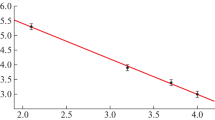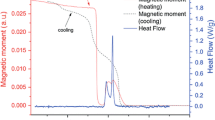Abstract
The crystallization behaviour of amorphous melt spun Fe82−x−yCr18ZrxBy (x=0–8, y=10–20) ribbons have been investigated using differential scanning calorimetry. The crystallization temperature and crystallization behaviour change with varzing Zr and B content.
The microstructural development during annealing of amorphous Fe64Cr18Zr8B10 has been investigated by a combination of transmission electron microscopy and energy dispersive X-ray microanalysis. Isothermal annealing for 2 h at temperatures in the range 600–1000°C produces a variety of different microstructures depending on the annealing temperature. At 600°C, the amorphous alloy partially crystallizes to a form a microstructure consisting of 9 nm sized bee ferrite grains embedded in an amorphous matrix. At temperatures in the range 700–900°C, the alloy microstructure transforms into a mixture of bee ferrite, faulted fcc MB12 boride particles and tetragonal M3B boride particles. At 1000°C, the faulted fcc MB12 boride particles are replaced by orthorhombic M4B boride particles.
Zusammenfassung
Mittels DSC wurde das Kristallisationsverhalten von amorphen schmelzgesponnenen Bändern aus Fe82−x−yCr18ZrxBy (x=0.8, y=10–20) untersucht. Die Kristallisationstemperatur steigt mit zunehmenden Zr-Gehalt. Mit steigendem B-Gehalt verändert sich das Kristallisationsverhalten.
Der mikrostrukturelle Werdegang während des Temperns von amorphem Fe64Cr18Zr8B10 wurde mit Hilfe einer Kombination aus Transmissions-Elektronenmikroskopie und energiedispersiver Röntgenmikroanalyse untersucht. Ein isothermes Tempern über zwei Stunden hinweg bei einer Temperatur zwischen 600 und 1000°C erzeugt eine Reihe von verschiedenen Mikrostrukturen-je nach Temperungstemperatur. Bei 600°C kristallisiert die amorphe Legierung partiell und bildet eine Mikrostruktur, die aus 9 nm großen bee Ferritkörnern, eingebettet in einer amorphen Matrix, besteht. Bei Temperaturen im Bereich von 700–900°C wandelt sich die Mikrostruktur der Legierung in ein Gemisch aus bee Ferrit, defekten fcc MB12 Boridpartikeln und tetragonalen M3B Boridpartikeln um. Bei 1000°C werden die defekten fcc MB12 Boridpartikel durch rhombische M4B Boridpartikel ersetzt.
Similar content being viewed by others
References
R. Ray, in B. H. Kear, B. C. Giessen and M. Cohen (eds.), Rapidly Solidified Amorphous and Crystalline Alloys, North-Holland, Amsterdam 1982, p. 435.
M. J. Rawson, D. J. Manley, H. A. Davies and J. E. Restall, in P. W. Lee and J. H. Mole (eds), Rapidly Solidified Materials—Properties and Processing, edited by American Society for Metals, Metals Park, OH, 1988, p. 37.
W. T. Kim, B. Cantor, K. Clay and C. Small, in P. K. Liau and M. N. Gungor (eds), Fundamental Relationships Between Microstructure and Mechanical Properties of Metal Matrix Composites, TMS, Warrendale, PA, 1990, p. 89.
W. T. Kim, K. Clay, C. Small and B. Cantor, J. Non-crystalline Solids, 127 (1991) 273.
S. Hahn, S. Isserow and R. Ray, J. Mater. Sci., 22 (1987) 3396.
R. Ray, V. Panchanathan and S. Isserrow, J. Metals, 35 (1983) 30.
S. Hahn, S. Isserow and R. Ray, J. Mater. Sci. Letters, 4 (1985) 972.
Author information
Authors and Affiliations
Rights and permissions
About this article
Cite this article
Chang, I.T.H., Ishii, K. & Cantor, B. Heat treatment of rapidly solidified Fe−Cr−Zr−B alloys. Journal of Thermal Analysis 42, 667–678 (1994). https://doi.org/10.1007/BF02546741
Issue Date:
DOI: https://doi.org/10.1007/BF02546741




